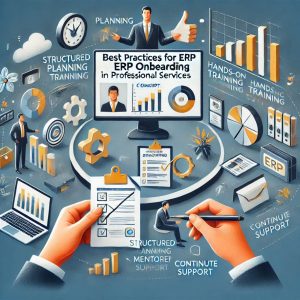Implementing a new Enterprise Resource Planning (ERP) system can significantly enhance efficiency and streamline operations within professional services. However, the success of this transition largely hinges on effective change management. Below are actionable strategies tailored for managing change during ERP implementation, ensuring your team adapts smoothly to the new system.
Understanding Change Management in ERP Implementation
Change management in the context of ERP involves preparing and supporting employees to transition from old processes to new ones. This organized approach helps mitigate resistance, fosters user adoption, and ensures minimal disruption to daily operations. Key components include clear communication, training, and ongoing support throughout the transition process.
Key Steps for Effective Change Management
- Involve Stakeholders Early
- Engage key stakeholders from the outset to gather insights and foster buy-in. Their involvement can help identify potential challenges and create a sense of ownership over the process.
- Conduct a Readiness Assessment
- Assess your organization’s readiness for change by evaluating existing workflows, employee skills, and potential resistance. This assessment will guide your change management strategy and training needs
- Develop a Comprehensive Communication Plan
- Clearly articulate the reasons for the change, expected benefits, and how it will impact employees. Regular updates via meetings, emails, or newsletters can help manage expectations and reduce uncertainty
- Clearly articulate the reasons for the change, expected benefits, and how it will impact employees. Regular updates via meetings, emails, or newsletters can help manage expectations and reduce uncertainty
- Create a Cross-Functional Change Management Team
- Form a team that includes representatives from all departments affected by the ERP implementation. This ensures diverse perspectives are considered and facilitates smoother communication across functions
- Form a team that includes representatives from all departments affected by the ERP implementation. This ensures diverse perspectives are considered and facilitates smoother communication across functions
- Provide Tailored Training Programs
- Develop training sessions that cater to different user groups within your organization. Focus not only on technical skills but also on how the new system aligns with their daily tasks and overall business goals
- Develop training sessions that cater to different user groups within your organization. Focus not only on technical skills but also on how the new system aligns with their daily tasks and overall business goals
- Monitor Progress and Adapt Strategies
- Track the implementation process closely to identify areas needing adjustment. Solicit feedback from users to refine training programs and address any ongoing issues
- Track the implementation process closely to identify areas needing adjustment. Solicit feedback from users to refine training programs and address any ongoing issues
- Address Resistance Proactively
Recognize that resistance is a natural response to change. Create forums for employees to voice concerns and provide reassurance through transparent communication about how their roles will evolve
8.Encourage a Culture of Flexibility
- Foster an environment that embraces change by promoting adaptability among employees. Highlight success stories of early adopters to motivate others and demonstrate the benefits of the new system
Conclusion
Transitioning to a new ERP system is not merely a technical upgrade; it is a transformative journey that requires careful management of both processes and people. By implementing these change management strategies, your organization can navigate the complexities of ERP implementation effectively, ensuring that your team is well-prepared to embrace new workflows and technologies.By focusing on clear communication, tailored training, and proactive engagement with stakeholders, you can facilitate a smoother transition that maximizes the benefits of your new ERP system while minimizing disruption to your professional services landscape.




